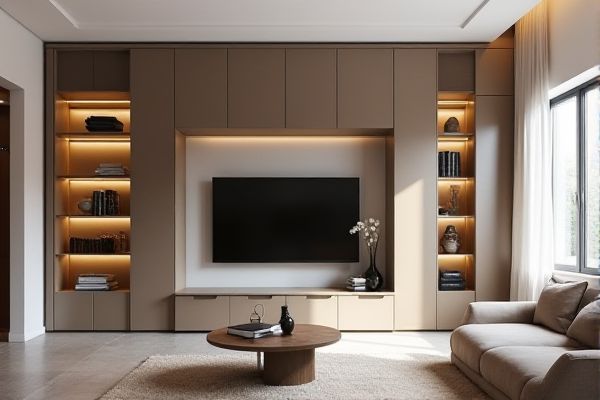
Wall-to-wall storage maximizes space by fitting seamlessly into your room's dimensions, offering a sleek and continuous look with customizable shelving and compartments to accommodate diverse items. Explore the rest of the article to determine which storage solution best fits your needs and lifestyle.
Table of Comparison
| Feature | Wall-to-Wall Storage | Modular Units |
|---|---|---|
| Design | Custom-built, fixed storage spanning entire wall | Flexible, movable units configurable to space |
| Installation | Permanent, requires professional fitting | Quick setup, can be DIY assembled |
| Space Utilization | Maximizes wall space efficiently | Optimizable, depends on unit arrangement |
| Customization | High customization in size and design | Moderate customization; interchangeable units |
| Cost | Higher upfront investment | Generally more affordable, scalable |
| Durability | Long-lasting, robust construction | Varies by material and build quality |
| Mobility | Fixed, non-movable | Portable and easy to relocate |
| Ideal Use | Permanent storage solution for organized spaces | Temporary or adaptable storage needs |
Wall-to-Wall Storage vs Modular Units: An Overview
Wall-to-wall storage offers a seamless, custom-built solution that maximizes every inch of your space with tailored shelves and compartments, providing a sleek and integrated appearance. Modular units provide flexibility and portability, allowing you to reconfigure or expand storage as your needs change, making them ideal for evolving spaces. Choosing between wall-to-wall storage and modular units depends on whether you prioritize permanent, optimized design or adaptable, adjustable organization for Your home or office.
Key Design Differences Explained
Wall-to-wall storage systems are custom-built to fit the exact dimensions of a room, providing continuous, seamless storage solutions that maximize space and create a unified aesthetic. Modular units consist of pre-manufactured components that can be combined in various configurations, offering flexibility but often resulting in visible gaps and less efficient use of space. The primary design difference lies in the customization level: wall-to-wall storage is tailored for integration and permanence, while modular units prioritize adaptability and ease of reconfiguration.
Space Utilization: Maximizing Every Inch
Wall-to-wall storage systems optimize space utilization by seamlessly integrating shelves, drawers, and compartments from floor to ceiling, eliminating gaps and wasted space. Modular units offer flexibility and customization but may leave unused gaps due to their segmented design, reducing overall storage capacity. Maximizing every inch of your room often means choosing wall-to-wall solutions for a continuous, tailored fit that fully capitalizes on available space.
Installation Process and Flexibility
Wall-to-wall storage requires a professional installation process involving custom measurements and fittings to maximize space utilization, making it a permanent fixture in the room. Modular units offer greater flexibility with easy assembly, reconfiguration, and relocation, allowing users to adapt storage solutions as needs change. The choice between the two hinges on the balance between tailored, fixed storage and adaptable, user-friendly setups.
Customization Options Compared
Wall-to-wall storage offers extensive customization options tailored to your specific space, allowing for seamless integration with existing architectural features and maximizing every inch of available area. Modular units provide flexibility through interchangeable components that can be easily rearranged or expanded, adapting to changing storage needs without permanent installation. Choosing between the two depends on your preference for a fully personalized, built-in solution versus the adaptability of modular designs.
Cost Considerations and Budget Planning
Wall-to-wall storage systems typically involve higher initial costs due to custom design, materials, and installation fees, making them a larger upfront investment compared to modular units. Modular storage offers flexible budgeting options with standardized components that can be added or reconfigured over time, minimizing immediate expenses and allowing incremental upgrades. Evaluating long-term maintenance and potential resale value is crucial for effective budget planning between these two storage solutions.
Aesthetic Impact on Interior Design
Wall-to-wall storage creates a seamless, integrated look that enhances the room's architectural features by eliminating gaps and maximizing space utilization, resulting in a clean and cohesive aesthetic. Modular units offer flexibility with customizable arrangements and styles, allowing for quick adaptation to changing design trends while providing distinct visual segmentation. Choosing between the two depends on whether a uniform, built-in appearance or versatile, individual pieces better complement the existing interior design scheme.
Durability and Maintenance Requirements
Wall-to-wall storage systems offer superior durability due to their fixed installation and use of robust materials like solid wood or metal, making them less prone to damage from frequent use. Maintenance requirements are minimal as these units are integrated into the structure, reducing exposure to wear and tear compared to modular units. Modular storage units, while flexible and easier to reconfigure, typically use lighter materials like particleboard or plastic, which may degrade faster and require more regular upkeep to maintain appearance and functionality.
Best Use Cases for Each Storage Solution
Wall-to-wall storage is ideal for maximizing space in large rooms or custom spaces, offering seamless integration and high-capacity organization for your entire collection of items or seasonal belongings. Modular units work best in smaller spaces or rental properties, providing flexibility to rearrange or expand storage as your needs change without permanent installation. Your choice depends on whether you prioritize permanent, built-in organization or adaptable, movable solutions for varied storage demands.
Choosing the Right Storage for Your Needs
Wall-to-wall storage maximizes space by providing custom-built solutions tailored to room dimensions, ideal for organizing large collections or creating a seamless aesthetic. Modular units offer flexibility and portability, allowing easy reconfiguration for changing storage needs or smaller spaces. Selecting the right storage depends on room size, budget, and whether permanent installation or adaptability is a priority.
 homyna.com
homyna.com